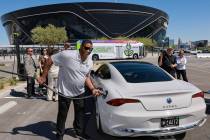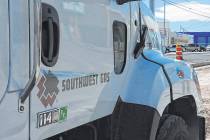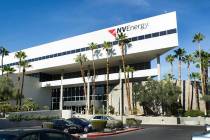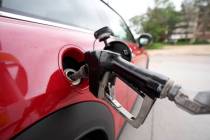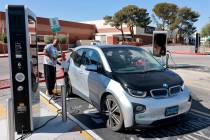Utah salt flats host alt-fuel vehicle tests
Since the 1920s and '30s when pro racer David Abbott "Ab" Jenkins shattered worldwide land speed records driving his "Mormon Meteor" on Utah's Bonneville Salt Flats, the playa has become one of the world's most famous raceways, where backyard builders have always raced alongside the finest automotive engineers in the world.
The Bonneville Salt Flats are located about 400 miles northeast of Las Vegas, near the Nevada border in Wendover, Utah. This geological treasure was formed on 159 square miles of salt deposits left behind by the evaporation of the prehistoric Lake Bonneville. The flats' special surface was first tested in 1912 for automotive land speed racing because the salt lakebed was so flat over such a long distance that a racer could see the curvature of the Earth. Also, the cooling effect and traction of the moist salt on tires allowed for faster speeds to be achieved than on traditional paved road surfaces.
Several organizations have continued to foster Jenkins' pioneering spirit and record-setting legacy at the Bonneville Salt Flats and, during the last several years, the flats have also been important proving grounds for alternative-fuel vehicle technologies. On Sept. 16-19, the third annual alternative-fuel vehicle time trials will be held at the Bonneville Salt Flats in conjunction with the Utah Salt Flats Racing Association's World of Speed events.
Ohio State University is an active participant in Bonneville Salt Flats land speed racing, where its student-run electric vehicle engineering programs have set international land speed records. In 2004, an undergraduate student team designed and raced the "Buckeye Bullet" streamliner to a new national land speed record of 315 miles per hour, becoming the first electric vehicle to officially exceed the 300-mph benchmark. The Buckeye Bullet employed a 900-volt rechargeable battery system to drive a 400-horsepower electric traction motor. This new record exceeded the team's record from the previous year of 257 miles per hour.
The Ohio State University team has also been involved with hydrogen-electric fuel-cell research efforts involving Ford Motor Co., Roush Racing and Ballard Power Systems. During Speed Week 2007, an experimental Ford Fusion 999 equipped with a fuel cell powered by two tanks of compressed hydrogen and helium-oxygen, showed that membrane fuel-cell technology could drive a 770-horsepower electric motor to average 207 mph on the Bonneville test track over two five-mile runs.
A fuel cell can be twice as efficient as an internal combustion engine by converting fuel directly into electrical energy, leaving only water at the its exhaust pipe, as opposed to CO2. However, because of this chemical reaction, there are also many problems to overcome before a hydrogen-powered fuel-cell vehicle can be put into mass production.
However, research into hydrogen fuel-cell technologies from 2000 to 2008 did provide many new engineering breakthroughs and achievements that have helped auto manufacturers develop better battery-powered and hybrid-electric vehicles. These successful efforts have led the major automakers to continue their research efforts into fuel-cell technology. In addition to the Ford Fusion hybrid product line, the Honda FCX Clarity is currently in testing at fleet locations in Southern California. General Motors Corp. made significant progress in developing the Chevrolet Equinox fuel-cell platform and Daimler Chrysler introduced a Mercedes-Benz F600 Hygenius concept car.
Hydrogen is the most readily available element for fuel usage in the world, as it can be released from water with a simple procedure called electrolysis that applies electricity to bubble the hydrogen out from H2O. Honda has made significant progress in developing a home-based hydrogen fueling station that converts household natural gas into hydrogen gas and can be installed directly to a natural gas pipeline in a home garage.
Smaller hydrogen fuel cells might also make good range extenders for recharging battery-powered electric vehicle battery banks during operation, in place of a hybrid gasoline engine generator. Instead of gasoline, the fuel cell would create electricity from hydrogen without any CO2 emissions. The GM Chevrolet Volt and its Voltec flexible fuels platform allow for this kind of hybrid configuration. Ford has also been actively researching this area by converting an Edge crossover SUV into a plug-in hybrid-electric vehicle that combines a small hydrogen fuel cell and battery pack to extend the range of its hydrogen/EV prototype.
For more information about alternative-fuel vehicle time trials to be held at the Bonneville Salt Flats, e-mail Kent Singleton of the Utah Electric Vehicle Coalition at kent@saltflats.com.
Stan Hanel has worked in the electronics industry for more than 30 years and is a long-time member of the Electric Auto Association and the Las Vegas Electric Vehicle Association. Hanel writes and edits for EAA's "Current Events" and LVEVA's "Watts Happening" newletters. Contact him at stanhanel@aol.com.











